chapter
Introducing Etherport.org
On the Web 2.0 content is cheap, fast, abundant, and addictive. It’s increasingly difficult to keep even the most dedicated readers interested as they grow more impatient, quickly distracted, and disengaged. Some say that critical reflection online is a mere fable from the past. But we believe that critical reflection is a powerful tool that allows one to formulate questions, confront bias, point out contradictions, and look for new directions. ‘We’ is the Hybrid Pubs research group, consisting of Ania Molenda, Anna Maria Michael, Ashley Maum, Carolina Pinto, Ebissé Wakjira, Gijs de Heij, Maria van der Togt, Ray Dolitsay, Sepp Eckenhaussen, and Victor Chaix. Especially in a time when navigating online media becomes so complex and confusing, it is of critical importance to find ways in which we could re-discover critical reflection and tool up for it. Based on this belief, we took on the challenge of redefining the cultural event report.

The Problem with Event Reports
Event reports are frowned upon, and rightly so. They’re mostly written as an institutional obligation to justify received funding. On rare occasions, someone manages to break the format and create something momentarily interesting. For instance, in the context of Going Hybrid, Clara Balaguer created the audio-text hybrid report ‘Please Turn the Page’: https://networkcultures.org/goinghybrid/2023/03/15/please-turn-the-page. But in reality, the majority of these reports read like the leftovers of an all-you-can-eat banket dinner, a patchy and chewed-out reminiscence of something you probably missed for good reasons, to begin with.
Nevertheless, we take a stance in defense of the event report. These past years the cultural sector seems to be stuck in an overhaul. The quantity of events organized in and by cultural institutions is staggering. Openings, symposiums, workshops, artist talks, and conferences follow each other in rapid succession. Each one puts an even more important matter on the agenda than the previous one. More often than not these events position themselves as offering a start. But what happens when the event is over? Where do all the cultural content, knowledge, and insights go?
Often, they are reduced to videoa 12-hour-long recording of the live stream on YouTube, with no means to decimate any of the information. Sometimes the interested secondary audience is blessed with an textautomated transcription, allowing one to scrape through some of the content. It seems that most of the cultural institutions are so busy organizing events, that the movements they aim to set in motion become an afterthought.
Many of us being cultural workers ourselves, we know the struggle to stay relevant whilst running on next to no funds all too well. In most cases, it’s not the lack of motivation, but a lack of means that creates the barrier to continue. During the Covid pandemic, this issue became more urgent than ever before. The necessity to engage with hybrid spaces, publics, and classrooms during lockdown acted as a pressure cooker for the ongoing redefinition of cultural publishing processes and reading experiences in the digital era. Some momentum appeared to redefine the event report, and we decided to ride the wave.
Expanding the Event Report - Best Practices
Our main objective was to to find new cultural and digital strategies that expand the room for reflection and collectivity, with the use of alternative ways of online publishing. In this process, we were keen to experiment with making event reports can more open-ended, multi-voiced, and non-linear. Instead of creating FOMO-inducing descriptions, or bureaucratic documents, we wanted to create a structure for event reporting that would give readers an interesting, explorative experience. We looked at textreal-time transcriptions and instant publishing, non-linear and modular formats, objecton-demand printing stations as part of spaceexhibitions, and audioaudio-texttext hybrids. We found inspiration in zines, websiteinteractive digital longforms, wikis, annotated maps, hybrid indexes, chat-to-print tools, objectbook printing machines, and performanceinterventions in spacepublic space. There are so many alternatives to the boring and bureaucratic event report! Among the interesting practices we found, five deserve a special mention:

Screenshot of an Are.na channel. Print Are.na scrapes the content of an Are.na channel and combines it into a printable file.
Print Are.na allows to make a objectbook from a websitepublic Are.na channel. Print Are.na was created by Mindy Seu, Charles Broskoski and Ekene Ijeoma. print.are.na uses bindery.js, an open-source library for creating books using HTML and CSS, created by Evan Brooks. The first version print.are.na was created by Callil Capuozzo for the 2017 Cybernetics Conference. Explore Print Are.na here: https://print.are.na. Are.na is a popular tool among creatives for public-private archiving which supposedly helps you to ‘organize your internet and expand your brain’. It allows to create simple collections by posting and reposting in a blog- or feed-like structure. Print Are.na scrapes a public Are.na channel, structures and paginates the content, and creates a printable .pdf. It can be used to print at home or create a serious book through the print-on-demand service Lulu.
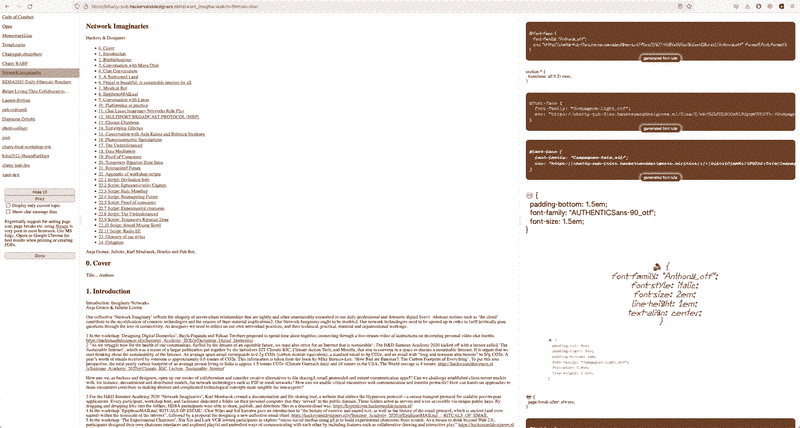
Screenshot of a ChattyPub publication on the website of Hackers & Designers.
ChattyPub is a design tool in the making developed by Hackers & Designers. Explore the ChattyPub archive here: https://chatty-pub.hackersanddesigners.nl. It leverages a chat interface to apply styles and formats to the content of a publication. ChattyPub is a collaborative publication/zine-making tool built on top of the chat platform Zulip. By sending messages, reacting with emoji and writing simple CSS style rules the publication can be collectively designed. Concretely, this means that every texttext sent in a chat is automatically added to the websitefront-end publication. The primary output of ChattyPub is a web publication, but objectautomated print versions of the files can be generated, turning the chats into hybrid publications. The use of ChattyPub requires chatters-authors to use basic coding, so it is not intuitively useable for anyone. However, with a little teaching, it’s a very low-threshold way of playfully publishing together with surprising outcomes. Some examples: https://chatty-pub.hackersanddesigners.nl/Open; https://chatty-pub.hackersanddesigners.nl/Lauren-Berlant; https://chatty-pub.hackersanddesigners.nl/photo-collage. With ChattyPub workshops, Hackers & Designers teach participants to use the tools and, ideally, create a publishing community in the process.
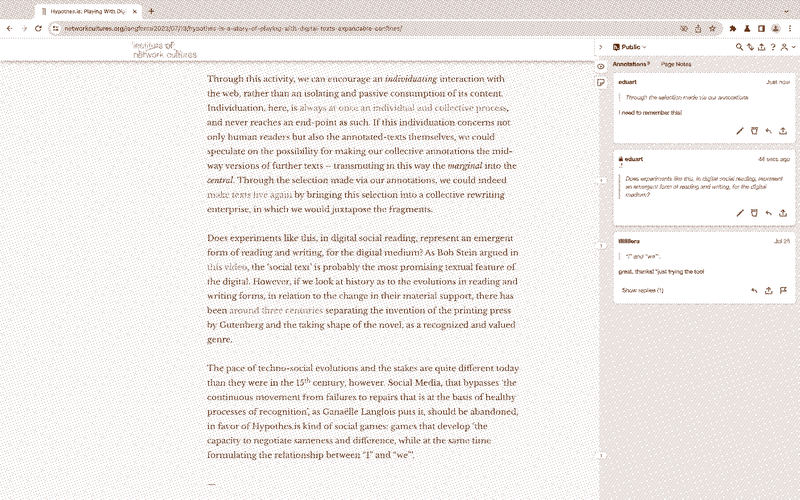
A screenshot of the Hypothes.is plug-in, overlaid on an article by Victor Chaix on the website of the Institute of Network Cultures.
Hypothes.is is a free Chrome extension that lets users websiteadd annotations to websites and have discussions on websites. Download and explore Hypothes.is here: https://web.hypothes.is. Opening this bookmarklet spaceprojects a transparent layer over any website, PDF or ePub, in which one can comment and annotate even when the original website does not provide that possibility. Moreover, other users opening that same text, will be able to see others’ annotations and react to them. Comments section on YouTube closed? Just open the Hypothes.is bookmarklet and comment away. It is obvious that Hypothes.is, as a unique and powerful tool against centralized power and censorship, is extremely promising for educators, journalists, researchers, publishers, and activists. However, it is evenly vulnerable to trolls and spam. Victor Chaix developed the idea of ‘digital social text’ using Hypothes.is. This idea is discussed in ‘Chapter 4: Forms of Hybridity’.
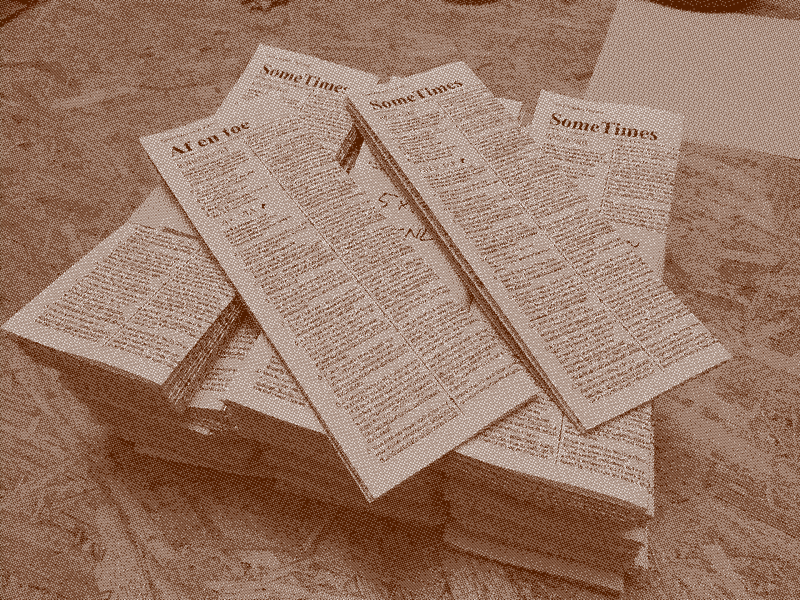
The print version of SomeTimes / Af en toe, the hybrid newsletter of Varia.
In 2022, Varia started publishing the hybrid, bilingual textnewsletter SomeTimes / Af en toe. Read SomeTimes here: https://varia.zone/en/sometimes-af-en-toe.html. The contents are created collectively by the members of Varia in OctoMode and published as text.pdfs and objectflyer-like prints. The format of these newsletters is a direct expression of the collective working process Varia uses. According to Simon Browne, contingent librarian and member of Varia, it cost some time to set up the template, but it’s pretty simple in its use. The .pdf newsletter is a seamless extension of the websiteVaria website, spreading news on events and projects to the collective’s (international) network of cultural workers, geeks, and organizers. The print version, which feels like a crossover of a flyer and a local newspaper, allows for a bigger spacepresence in the Rotterdam neighborhood. This reflects a tendency within Varia during the lockdowns, to not go online, but to focus on the hyperlocal and provide a community space. Urgent, hybrid publication in the arts doesn’t always equal digitization, but rather an adaptive workflow and method that allows for the right hybrid format according to needs.
To question and circumvent paywalls that enclose knowledge that should be public, Maria van der Togt has created the artwork Hard Copy Soft Copy—Impermeable Domains (2021). Read more about the work here: https://sandberg.nl/alumni/maria-van-der-togt/work/hard-copy-soft-copy–impermeable-domains. The work consists of websitea virtual platform with an open-source collection of textdigital publications, run on a objectraspberry pi, and a spacespatial printing and binding set-up. Members of the public use the objecton-site computer to select any of the documents and performanceprint and bind it on the spot. In rescuing material from the clutches of corporatization, the work upholds the true definition of ‘public’ through the simple gesture of providing resources without any expectation of return.
The Threshold of Experimental Publishing
However exciting these examples, we also ran into a paradox between the need of urgently building forms of publishing resistance and the general slowness with which many online users embrace the tech. Introducing new tools or methods will always require curiosity and most likely will push audiences outside of their comfort zone. Yet the experimental side of tech in its geekiness tends to create a literacy barrier that scares away many older and younger folks relying on the frictionlessness of contemporary corporate UIs. As a result, experimental publications are often inaccessible and unfit to create more critical mass for resistance in online media. The precarious state of critical online reflection is discussed at more length by Ania Molenda in ‘Online Critical Reflection, a Fable from the Past?’
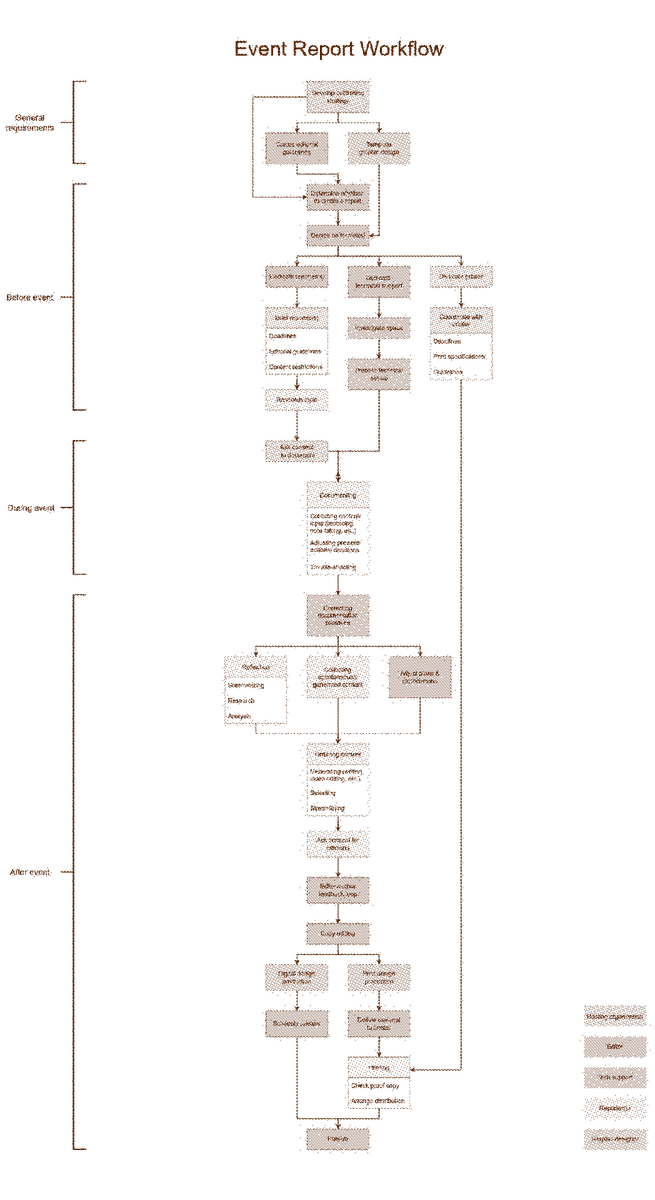
A mapping of the hybrid event reporting workflow created by the Hybrid Pubs research group. You can download the PDF and read more about the workflow on the Going Hybrid research blog: https://networkcultures.org/goinghybrid/2022/10/12/workflow-improvements-for-hybrid-event-reports.
We do not have the perfect solution for this dilemma. But we did find an approach to do meaningful work. Rather than focusing on ‘tech solutions’, we focused on content and working methods. Our methodology was, as Coko calls it, ‘workflow-first design’: https://coko.foundation/blog/understanding-workflow-first-design.html. We mapped the event report creation workflow and discussed possible experiments to see where interventions and hybridizations would be possible, without creating too many barriers or extra worlkload. Read about this process here: https://networkcultures.org/goinghybrid/2022/10/12/workflow-improvements-for-hybrid-event-reports.
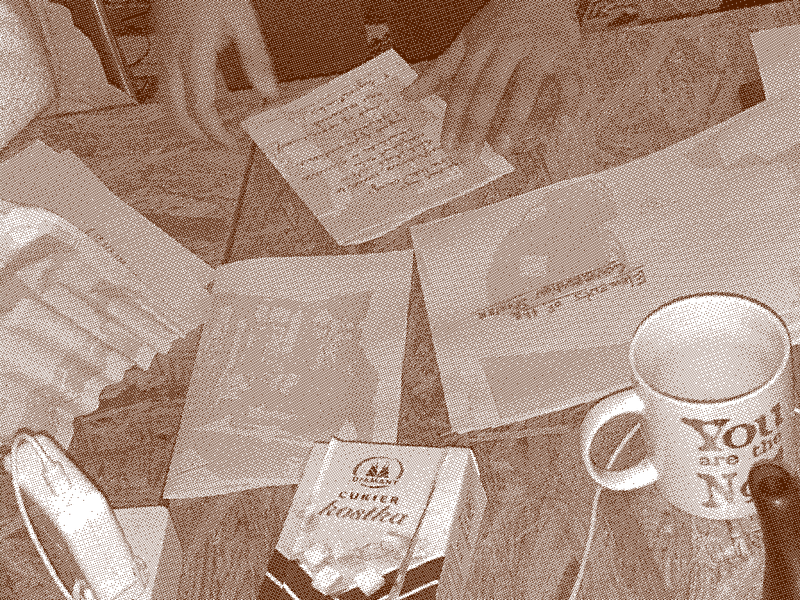
An action shot of the Hybrid Pubs sprint day at Varia in Rotterdam.
Also, we focused on content, having long discussions about what content makes event reports worth reading, what the role of the editor is, how to create space for the author as a craftsperson, and other editorial matters. These conversations led to a taxonomy of elements that make event reports worth reading, which were collected in the Minizine: Elements of a Conversation Starter. Read the Minizine here: https://networkcultures.org/goinghybrid/2022/11/14/minizine-elements-of-the-conversation-starter
A Look at Etherport
Only after the focus on content, we turned to tech, and created a proposal to continue experiments: Etherport. Visit and try Etherport here: https://etherport.org/publications/.
Etherport is a tool for cultural organisations to make more experimental, multi-voiced, and non-linear event reports. The tool helps to standardize the event reporting workflow, reducing production workload and clarifying the role division between authors and editors. It was built by the research group using the hybrid publishing tool Ethertoff, developed by Open Source Publishing collective in Brussels. Ethertoff is a simple collaborative web platform, much resembling a wiki but featuring real-time editing thanks to Etherpad. Its output is constructed with equal love for print and web. Learn more about Ethertoff and Open Source Publishing here: Ethertoff is a simple collaborative web platform, much resembling a wiki but featuring real-time editing thanks to Etherpad. Its output is constructed with equal love for print and web. Let us show you…
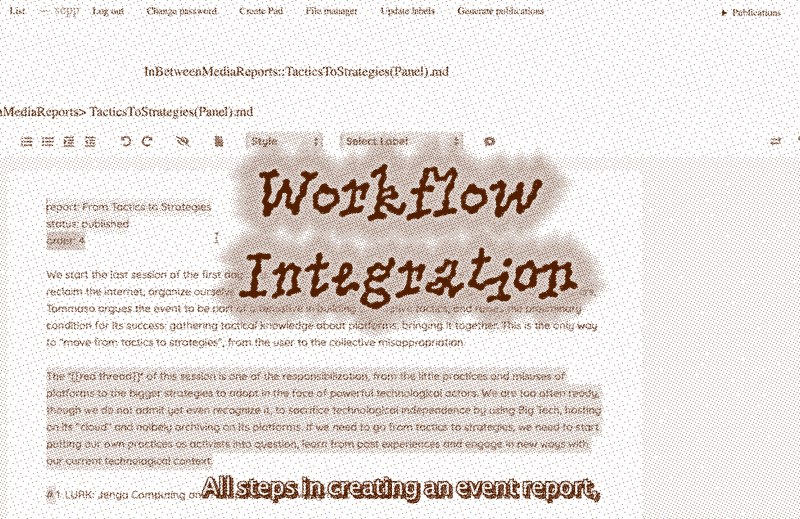
All steps in the creation of an event report, from (real-time collaborative) writing to editing and publishing, are integrated in Etherport.
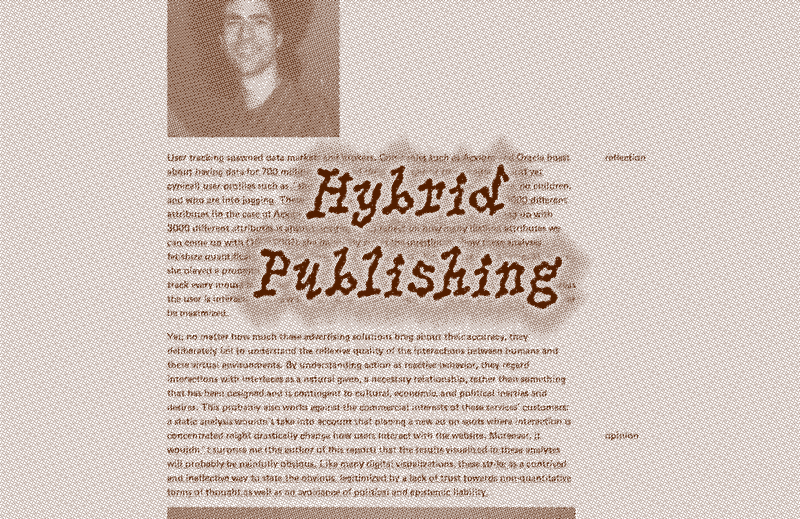
Publisihing an event reports on Etherport generates two versions simultaneously: a websiteweb version, and a objectprintable .pdf.
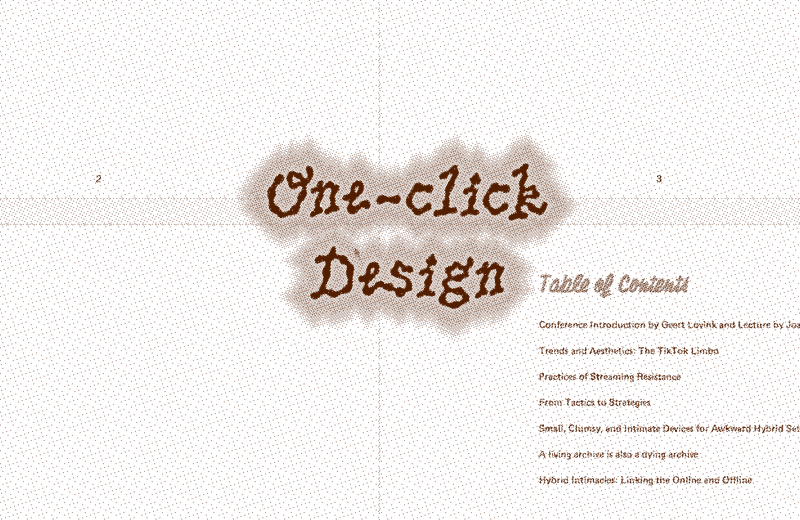
Both the web version and .pdf of your publication are automatically designed using a template. (It is possible to create your own template, to match the visual identity of your organisation, in CSS.)
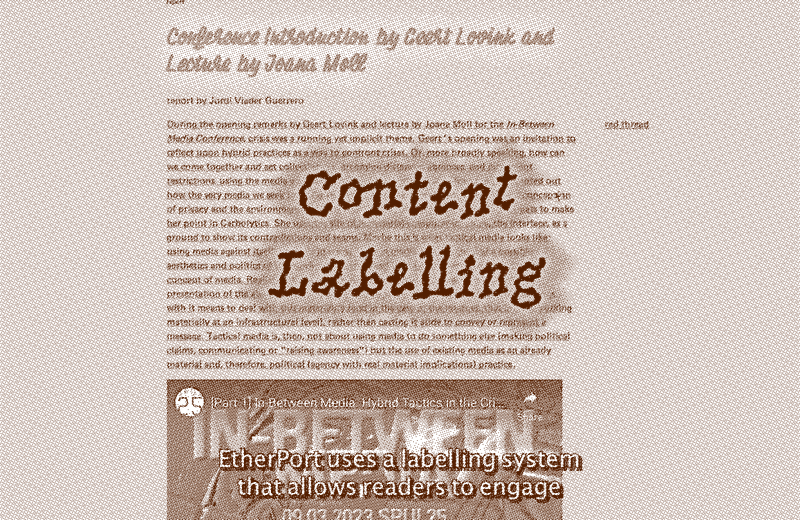
Etherport uses a labeling system that allows readers to engage with the event report in a non-linear way based on theme or type of content. This same feature creates links between reports of different events, which makes it easier to nagivate and activate the event report archive.
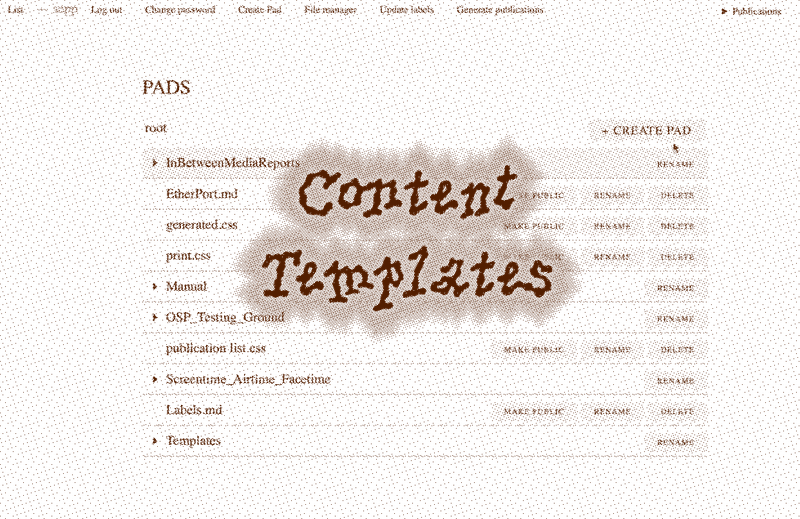
To accomodate custom serialization, it is possible to create pad templates for different types of reports/publications.
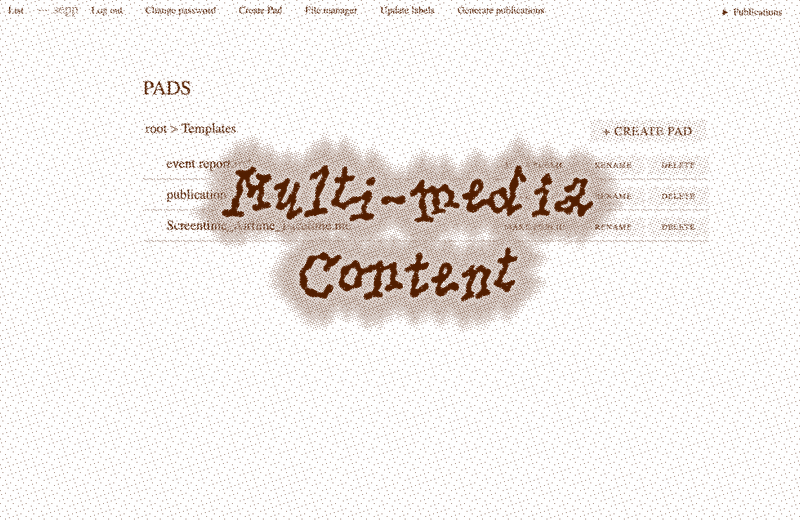
Etherport supports texttext, still imageimages, videovideos, and timestamps.
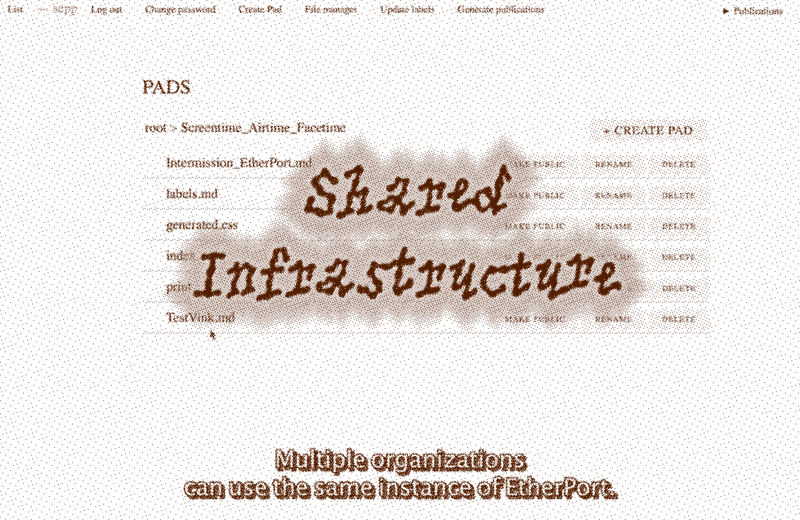
Multiple organisations can use the same instance of Etherport. This shared infrastructure can grow into a shared archive of event reports, in which relations between events from different organisations become visible and navigable.
The Future of Etherport
At the time of the publication of Screentime Airtime Facetime, Etherport is a working prototype. To get a feel of the output of the tool, you can have a look at the conference report of In-between Media that was created with Etherport. You can find the conference report here: https://generated.going-hybrid.gutenberg.club/InBetweenMediaReports
During the first six months of 2024, the Etherport will be developed from a prototype into a fully functional tool by Open Source Publishing and the Institute of Network culture, in collaboration with a group of core users. The outcomes will include a stable, freely usable web tool, and a manual for aspiring users.
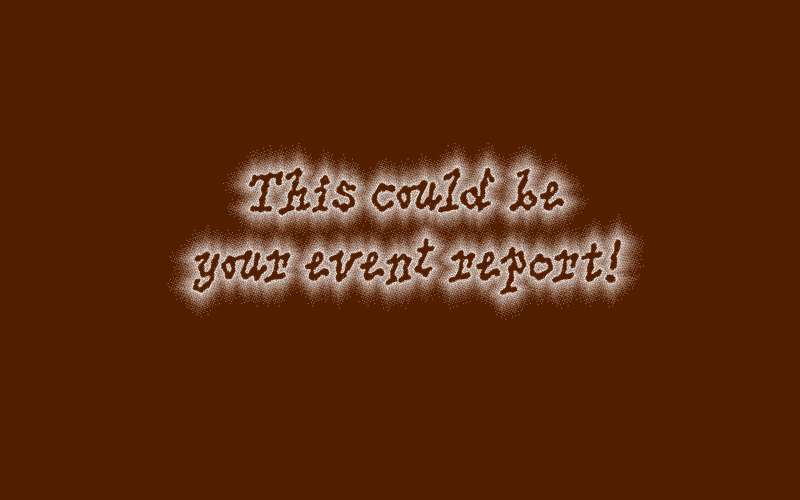
Are you interested to learn more about Etherport, or to try it out for yourself in the early stages? Please send an email to sepp@networkcultures.org.
About this Text
This intermission was originally part of the Screentime Airtime Facetime livestream as a pre-recorded video. The text draws on blog-posts by Ania Molenda, Ashley Maum, Ebissé Wakjira, Gijs de Heij, Maria van der Togt, and Sepp Eckenhaussen. The video was edited by Ray Dolitsay, with voice-over by Carolina Valente Pinto and Sepp Eckenhaussen. You can the video through this link: https://networkcultures.org/goinghybrid/2023/11/16/introducing-the-etherport/